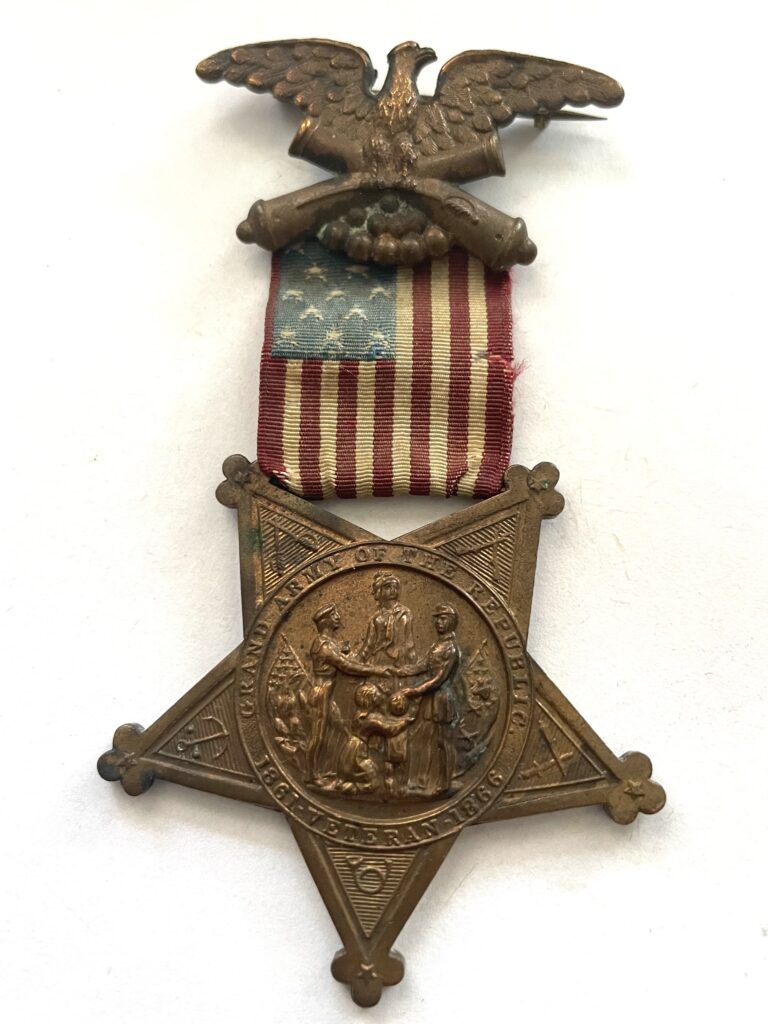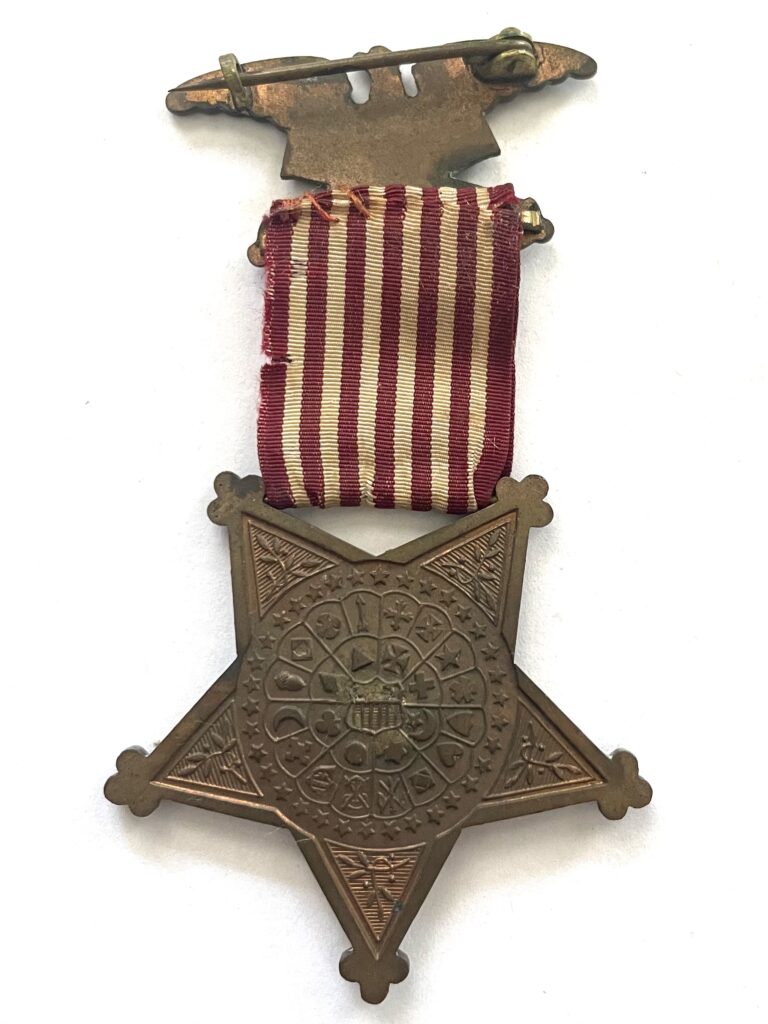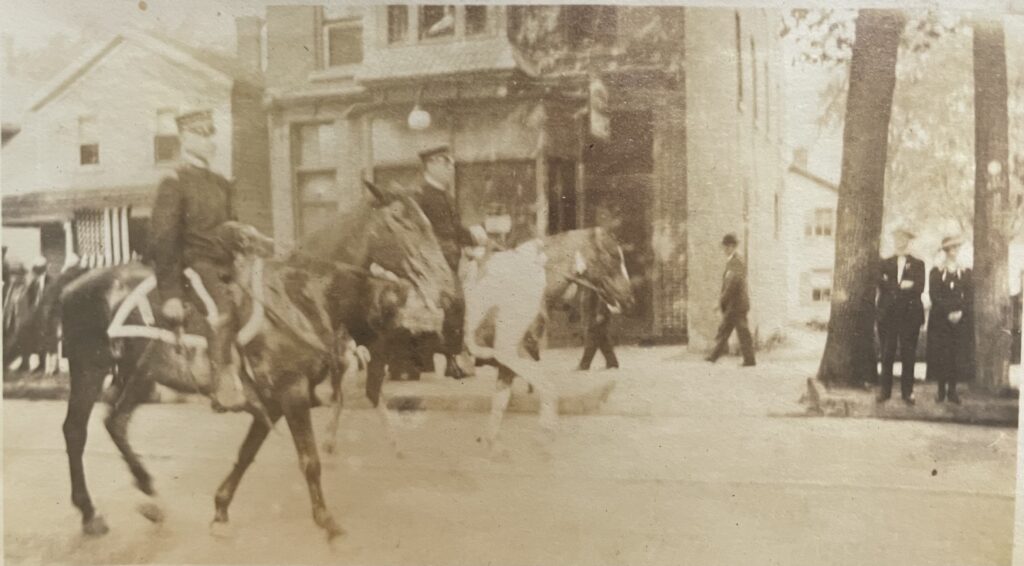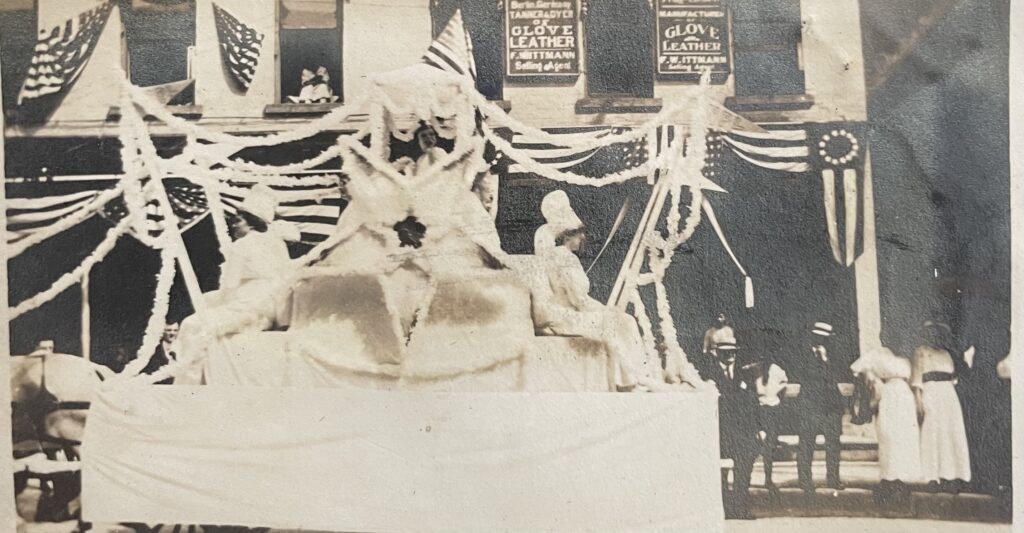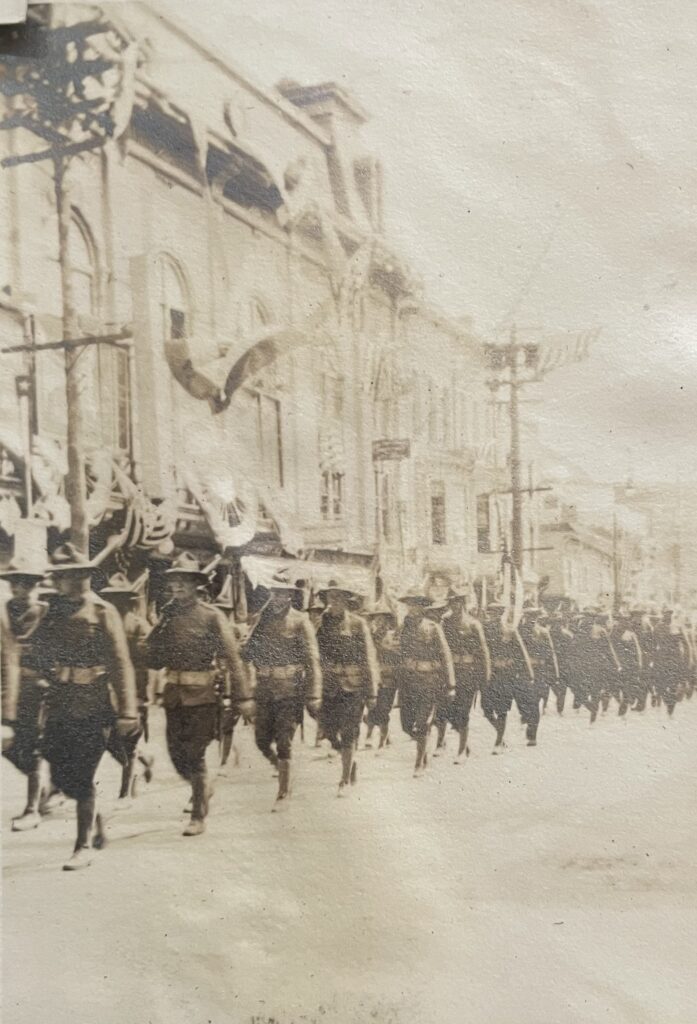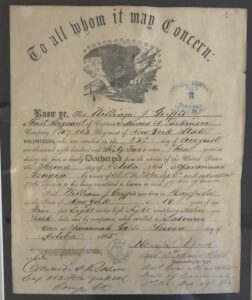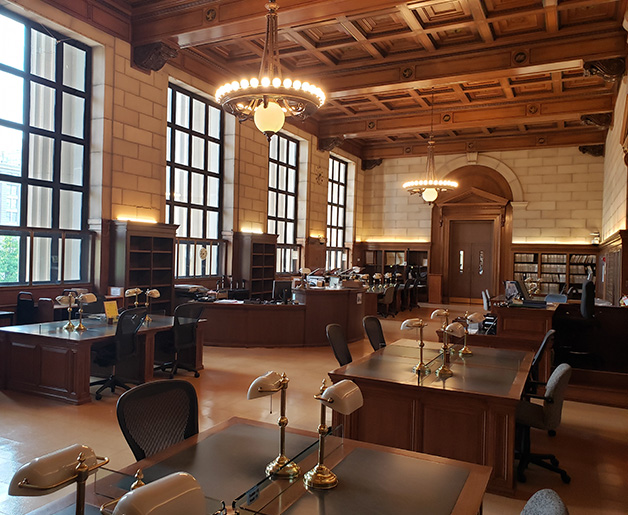In addition to having the Civil War discharge paper and musket of William J. Griffis, handed down through successive generations, there are an assortment of civil war and Grand Army of the Republic (GAR) uniform buttons and civil war veteran medals in the family archives. The buttons and medals probably passed from William J Griffis to his son Charles and in turn to Harold Griffis.

They are physical remnants of post-Civil War organizations that affirmed the identity of a veteran or a son of a veteran that fought in the Civil War. They also were the physical trappings of an allegiance to a group of individuals who shared memories and physical experiences of war that divided a country. These buttons, membership medals, community meetings and commemorations, and “Camp Gatherings’ provided a social base for “the preservation of the grand results of the war”. These grand results included the preservation of ‘fraternal feelings’ (story telling and remembrance of the past); providing social networks to provide veteran assistance; providing for the support, care, and education of soldiers’ orphans, and maintenance of their widows; the protection and assistance of disabled soldiers; furthering the goals of veteran pensions; and promoting the visibility of veteran’s affairs to the general public.
There are two types of buttons in this family assortment. One type of button has the initials ‘GAR’ (Grand Army of the Republic) on them and a second set has an eagle with either a shield or initials in the chest of the eagle. There are also two sizes of GAR buttons. The large buttons were breast coat buttons and the smaller sized buttons were for the sleeves.
The second set of buttons have eagles with various types of shields. They are Civil War uniform buttons. There are seven buttons with eagles with wings outstretched that have shields on their chest.
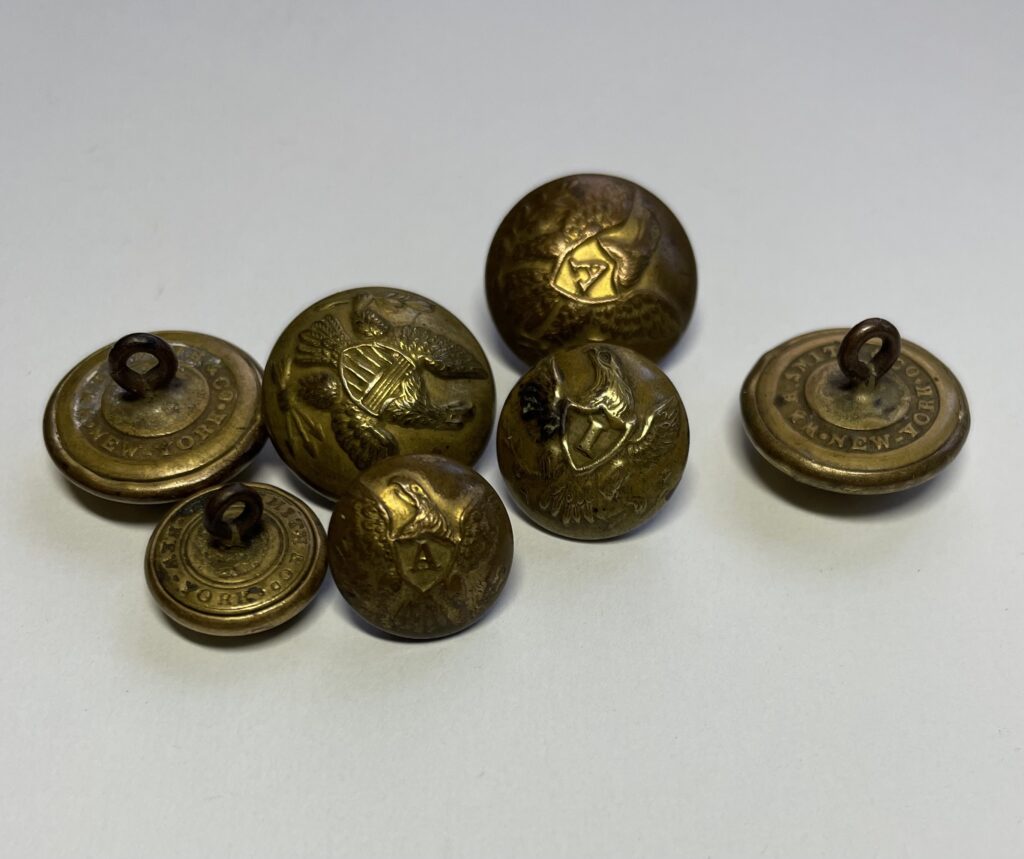
Prior to and during the Civil War, Scovill was the most prolific of button manufacturers. The Scovill name is common on buttons from the 1830’s to the 1970’s. The original Scovill partnerships and companies that had contracts for making buttons were located in Waterbury, Connecticut. Oftentimes the name Waterbury also appears on Scovill buttons. The brothers J. M. Lamson Scovill and William Henry Scovill operated the business from 1827 to 1840. [1]
One of the coat buttons has an eagle with a flat lined union shield. The backmark (underside) of the button has the inscription: Scovill MFG C WATERBURY. Backmarks with variations of Scovill Manufacturing began about 1850 (for example, Scovill MG.- early 1850s, Scovill MF’G – mid 1850s). Some of the buttons reference the division of the army on the eagles’ shield, with “I” representing the Infantry, “C” for Calvary, and “A” the Artillery. The buttons with the division significations were made by Scoville between 1821-1902. Buttons with eagles with a flat lined shield were made between 1854-1875. The necks on the eagles for all of these buttons lean to the left. The eagle buttons in our possession were probably made in the the late 1850’s and early 1860’s.
This may have been one of William J Griffis’ buttons that was from his uniform when he was in the 153rd New York Volunteer Infantry Regiment. [2] It is a button that is 5/16th of an inch wide. It was probably a sleeve uniform button.
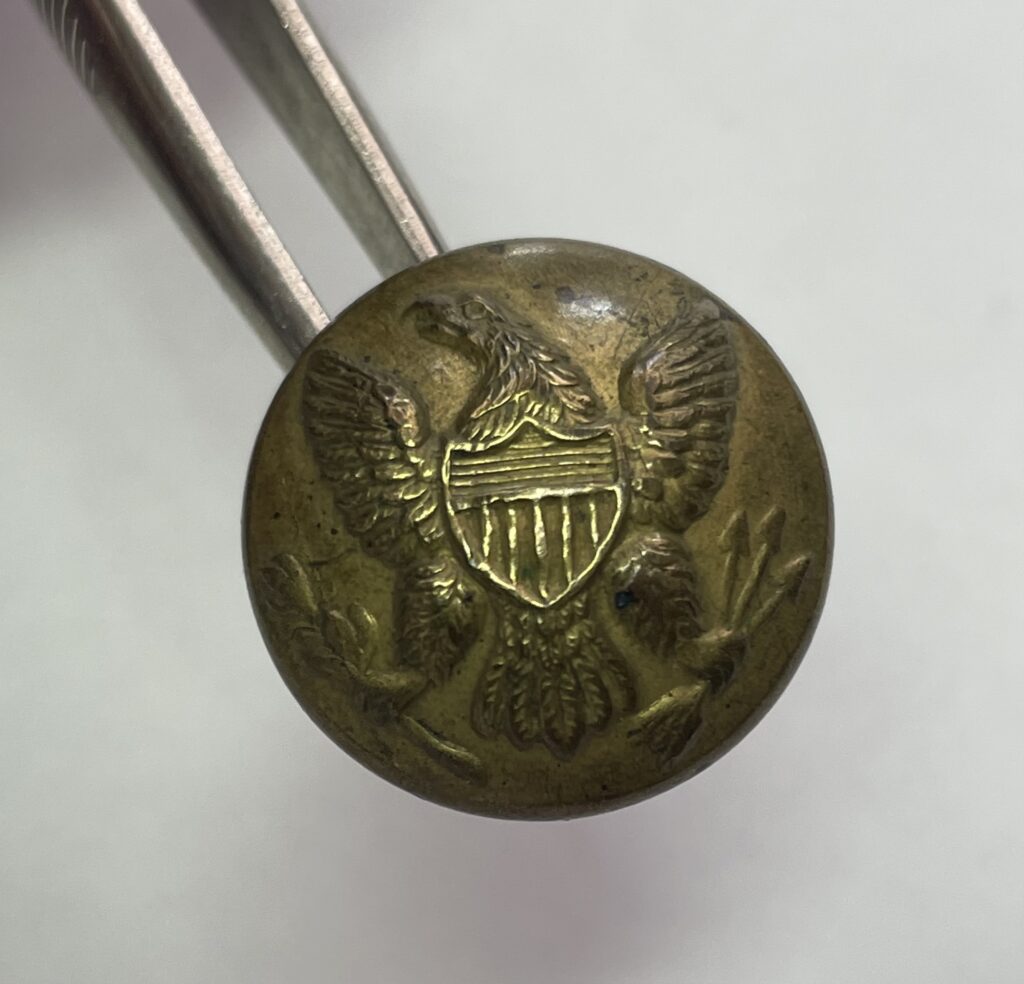

There is one button in the collection with an “I” in the eagle’s shield, signifying infantry. Since William Griffis was in a New York Volunteer Infantry Regiment, this very well could have been one of his uniform buttons. This button has “H.Bros.&Allien. NY” on the back mark of the button. The backmarks are raised in a depressed channel. This type of button generally dates from the 1830s to 1850s.
The “H. Bros.&Allien.NY” refers to Horstman Brothers & Allien, a manufacturer of the button that was located in New York. Manufacturer and retailer of civilian and military equipment, William H. Horstmann (1785-1850) originally established a manufacturing, importing, and retail business in Philadelphia, Pennsylvania, in 1816. His firm consisted of two companies: one dealt in civilian clothing and goods, and the other in military uniforms and equipment. After his sons, William H. Horstmann (1819-1872) and Sigmund H. Horstmann (1821-1870) joined the firm, they established another branch of the business in New York, NY. The firm was also called William H. Horstmann & Sons (1843-1893, Philadelphia), Horstmann Bros. & Company (1850-1852, New York; 1859-1893, Philadelphia), Horstmann Bros. & Allien (1852-1877, New York), Horstmann Sons & Drucker (1845-1849, New York), The William H. Horstmann Co. (1893-1940, Philadelphia). [3]
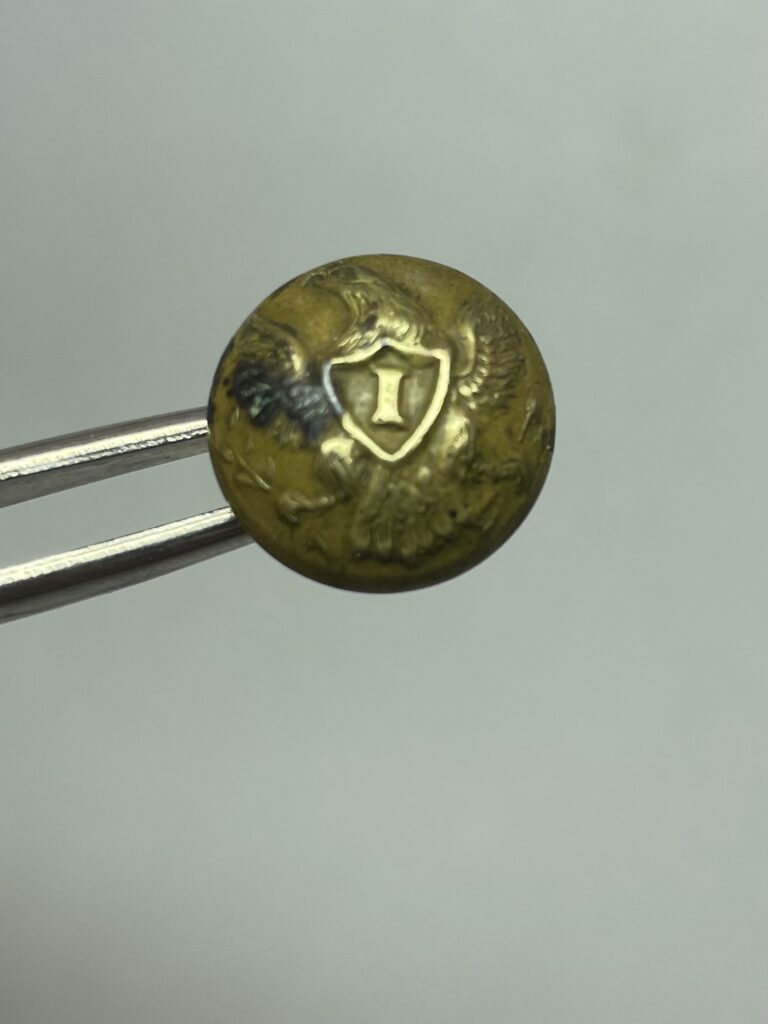

The remaining five buttons are eagle buttons with an “A” in the eagle’s shield. Two of the buttons are 3/4 inch wide and remaining three are 1/2 inch wide buttons. They all have “W.H. Smith & Co. New York” on the backsides of the buttons. The back marks on the 1/2 inch buttons have depressed marks (the lettering looks like it was hand stamped into the metal). This type of button typically dates from the 1860s and later. The larger buttons have backmarks with a raised mark in a depressed channel. This type of design generally dates from the 1830s to 1850s. [4]
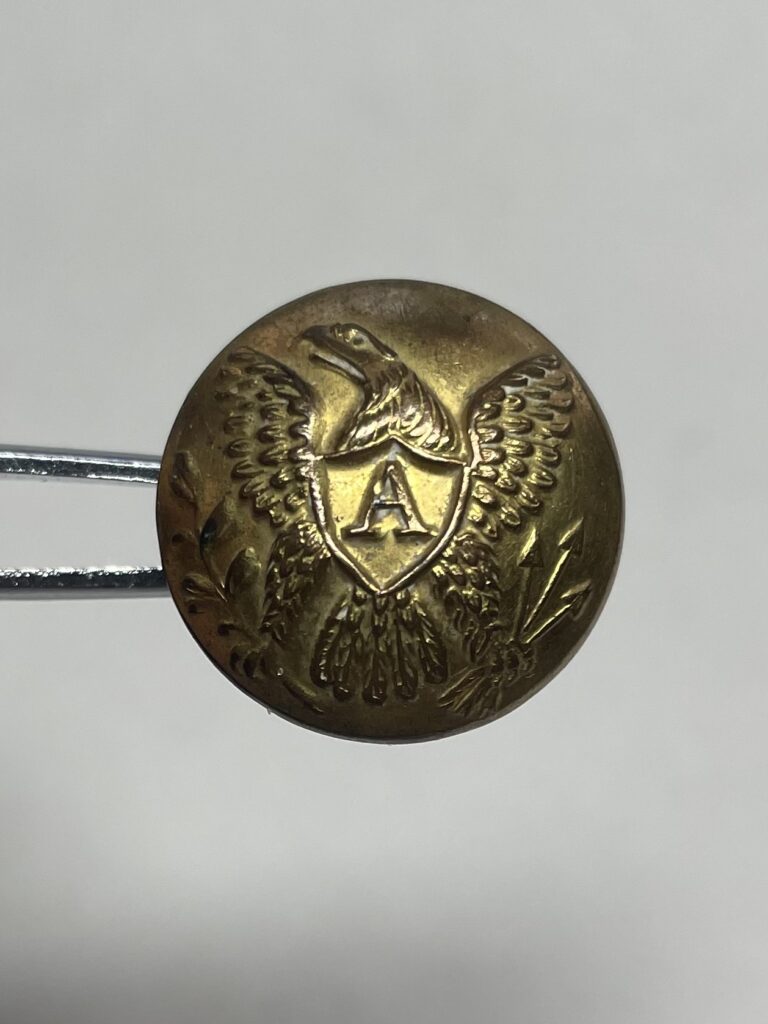

There are no known relatives that were assigned to Civil War artillery units. It is not known who were the original owners of the Artillery buttons. It is conceivable that William or his son Charles acquired the “A” buttons from someone they knew or through their association with veterans organizations.
Whether the buttons were the original buttons on the uniform of William Griffis is not certain. William Griffis was active with the Grand Army of the Republic after he mustered out of the service. William’s son Charles Arthur Griffis was a member of the “Sons of Veterans of the United States of America” (SVUSA). Both father and son may have collected civil war buttons or wore some of these buttons on a uniform while participating in events with the SUVCW.
Grand Army of the Republic (GAR)
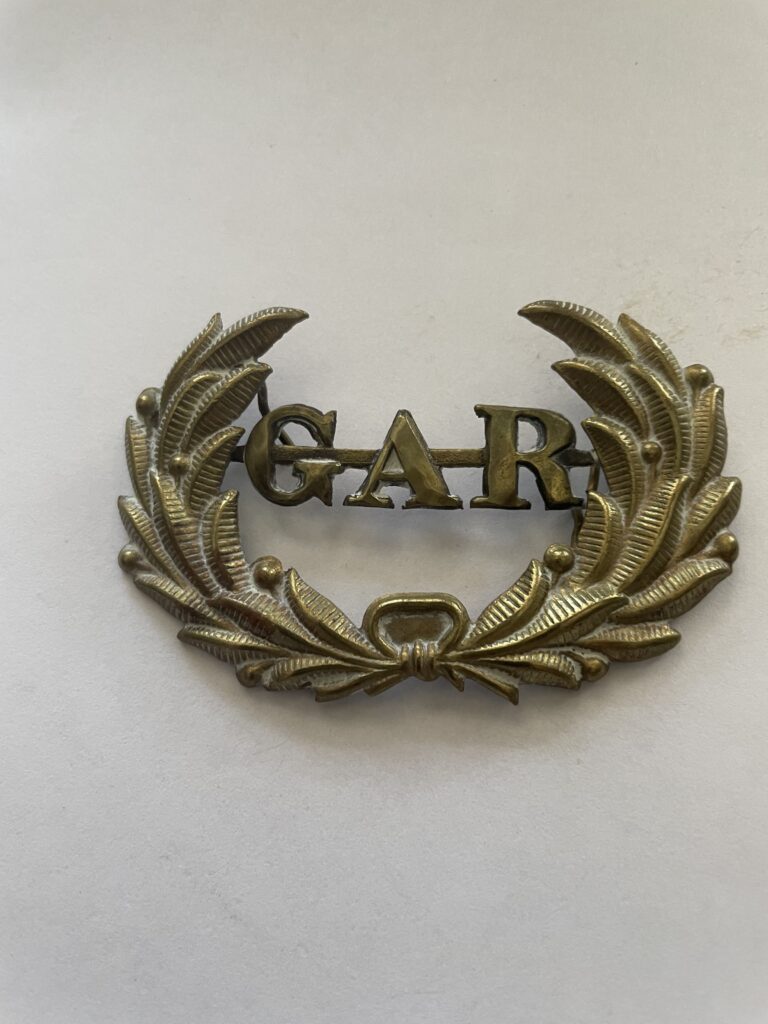
William Griffis may have been a member of the GAR Willard Allen Post, in Johnstown, Fulton County, New York. The post was in existence in May 1869 when Memorial Day was originally observed. [5]. Although these historical artifacts and newspaper articles document William’s membership with the GAR, there are no known documents that link William to a specific GAR Post. Since he lived in Johnstown, it is assumed that he was affiliated with of the Johnstown Posts.
At the close of the Civil War, there were over a million men in the Union armies. Nearly two and a half million had served for the Republic during the four long years of warfare, of whom three hundred and fifty-nine thousand had died. Most of those still in service at the end of the war disbanded and returned to civilian life. This general disbandment was largely effected after a grand parade of the armies of the Potomac, the Tennessee, and of Georgia, on May 22 and 24, 1865. One hundred and fifty thousand men marched through the wide avenues of Washington in review before the President and the commanding generals. [6]
“From the glare and glory, the power and prestige of the soldier’s career, they went into the obscurity of the peaceful pursuits of American citizenship, and in a few short months the vast armies of the United States had disappeared. The great war was ended, but it would have been strange indeed if the memories of those years of storm and stress, the sacrifices of those who had fallen, the experiences of the march, the battlefield, and the camp, and the needs of their disabled comrades, and of the widows and the orphans had been forgotten.”[7]
Founded in Decatur, Illinois on April 6, 1866 by Benjamin F. Stephenson, membership to the GAR was limited to honorably discharged veterans of the Union Army, Navy, Marine Corps or the Revenue Cutter Service who had served between April 12, 1861 and April 9, 1865. The community level of the organization was called a “Post”. Each Post was numbered consecutively within each department. Most Posts also had a name and the rules for naming Posts included the requirement that the honored person be deceased and that no two Posts within the same Department could have the same name. The Departments generally consisted of the Posts within a state and, at the national level, the organization was operated by the elected ‘Commandery-in-Chief’. [8]
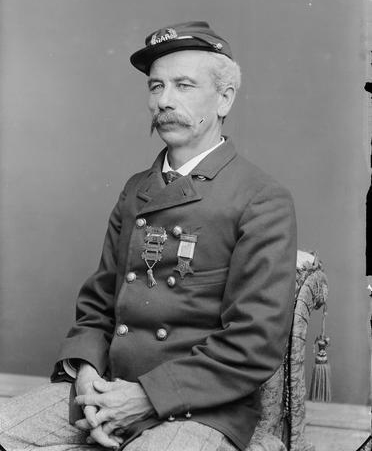
Groups of veterans began joining together under the aegis of the GAR first for camaraderie and then for social service and political power. By 1890 the GAR would roughly number 409,500 veterans of the “War of the Rebellion”. The organization represented a potent political force for pension advocacy and legislation, and social assistance and active relief work for veterans and families.
The GAR was influential in establishing Memorial Day. Memorial day was originally proclaimed on 5 May 1868 by General John Logan, national commander of the Grand Army of the Republic, in his General Order No. 11, and it was first observed on 30 May 1868, when flowers were placed on the graves of Union and Confederate soldiers at Arlington National Cemetery.
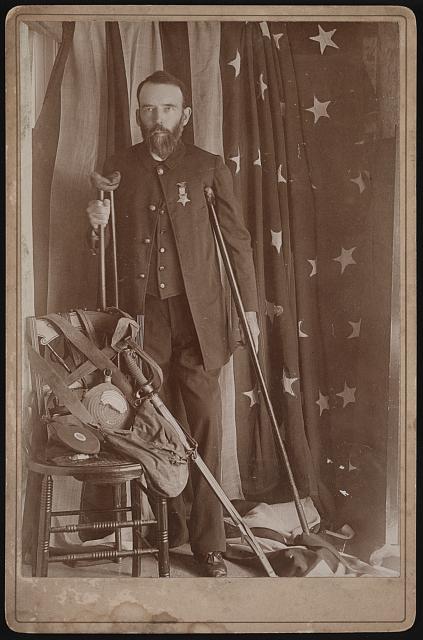
For GAR formal gatherings, for the first few years veterans typically wore the uniform they had when mustered out. By the 1880s, those uniforms were no doubt worn thin and perhaps did not fit anymore and were put aside. In the 1880s era the GAR uniform had a notched rolling collar and was adopted by the many of the GAR organizations. Usually rank insignia was not worn since the soldiers were civilians. By the 1890s rank insignia was being worn in some cases. The photo to the right depicts the GAR uniform of the 1880’s. [9]
The top photograph in this story as well as the two below depict the GAR uniform buttons (breast and cuff buttons) that were in the possession of William and his son Charles Griffis.
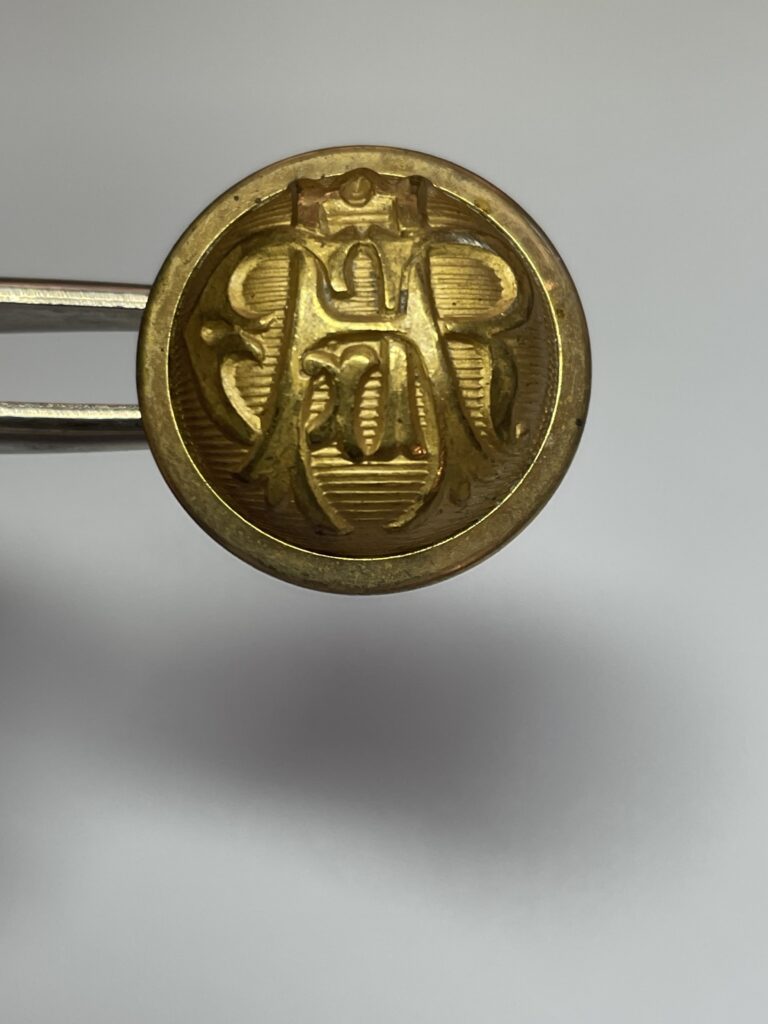
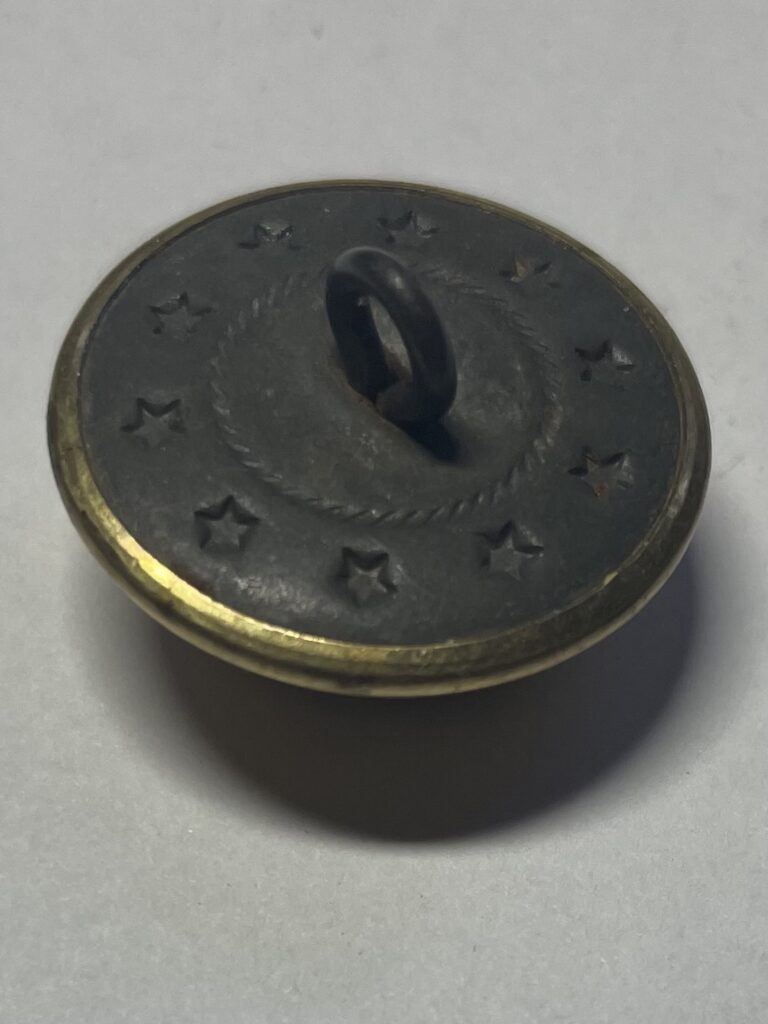
GAR Membership Medals
The general design of the badge was in use since 1869. The pendant of the badge is a five pointed star, like the Medal of Honor granted by Congress. The face of the medal has the Goddess of Liberty in the center, representing loyalty, and on either side stands a soldier and a sailor clasping hands in front of the Goddess to represent fraternity. Two children are kneeling in the foreground to receive a benediction and the assurance of protection from soldiers. This is the symbol of charity. On each side of this center group are the flag and eagle representing freedom and an ax and a bundle of rods for union. In the star points are the emblems of different arms of service, bugle for infantry, cannon for artillery, muskets for marines, swords for cavalry, and an anchor for sailors. Surrounding the center is the legend, Grand Army of the Republic, 1861 Veterans -1866, the later date commemorating the close of the war and the founding of the order.
The membership medal was designed and required for GAR membership. Each member was required to purchase their medal from the official quartermaster. To prove that the medals were authentic and properly obtained, a small alpha-numeric serial number was stamped on the edge of every official medal. The first was a letter that corresponded to the G.A.R. Commander of the year, and subsequent next digits were a sequential number. There were no records kept on which veteran purchased which medal. [10] In 1879, Ulysses Grant was presented with a gold version of the Gar membership medal [11]
There were three medals in William’s possession. Two of the medals were membership GAR medals and the third medal was a regiment membership medal. The following medal is in very good condition. The ribbon has minimal damage and the colors of the ribbons are still vibrant. The serial number B31848 on the edge of the star can still be read. Based on the serial number , there were seven commanders in chief whose last names began with a “B” [12] :
- Ambrose Burnside 1871-72
- Robert Beath 1883
- S.S. Burnett 1885
- John Black 1903
- Wilman Blackmor 1904
- Robert Brown 1906
- Charles Burton 1907
Since this medal is is relatively good condition, it is assumed that William purchased this medal to replace his order membership medal. It may have been purchased in the early 1900’s. William Griffis passed away in 1908.
The second membership medal is not in the same condition as the first medal. The ribbon is basically destroyed. However, the serial number W1048 can still be deciphered. Based on the serial number, there were five commanders in chief with last names beginning with “W” [13]:
- Louis Wagner 1880
- William Warner 1888
- A.G. Weissert 1892
- Ivan Walker 1895
Since the medal came into widespread use in the 1880’s, it is assumed William obtained this medal in 1880 or 1888 and probably was his first medal that he purchased.
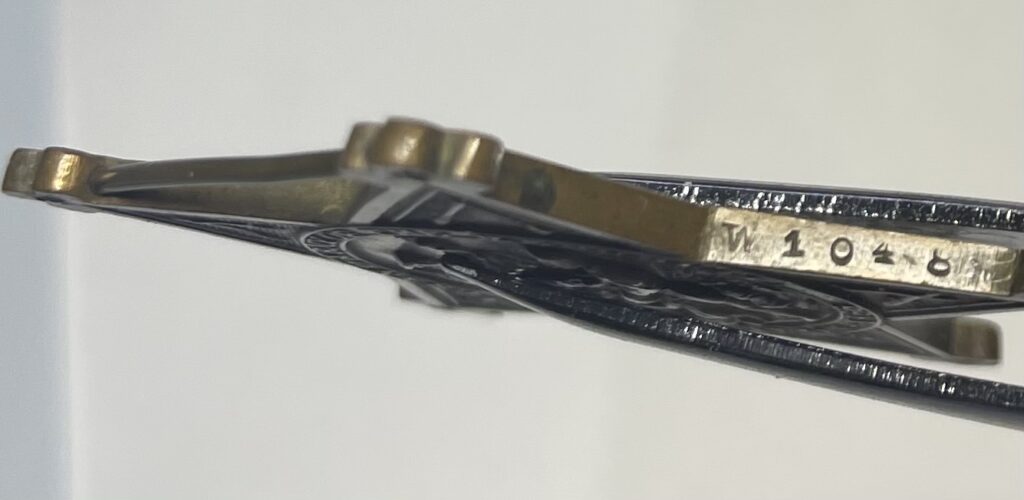
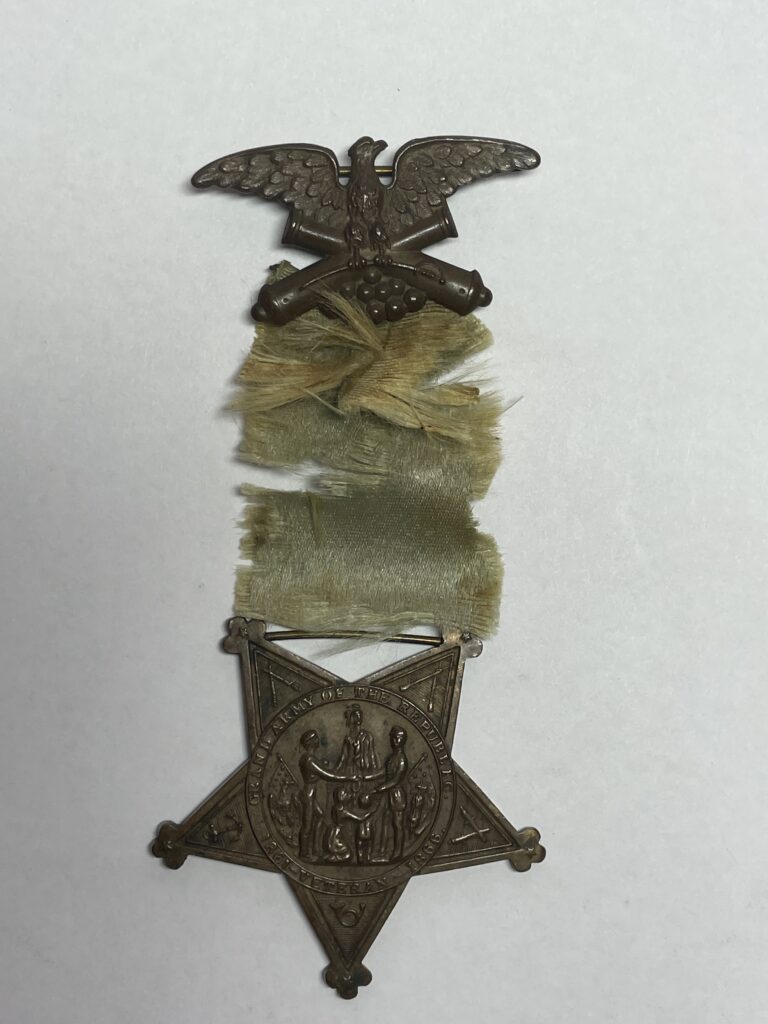

The third membership medal represents William Griffis’ participation with the 153rd Infantry Regiment of New York Volunteers. The medal depicts a particular time of service when the regiment served in the Department of the Gulf and 1st Brigade, 1st Division, 19th Corps, from February, 1864 to March 1865. During this time the regiment took part in the Red River campaign, meeting with severe losses at Pleasant Hill. It was also active at Mansura and was commended for its bravery in these battles by the commanding general. [14]
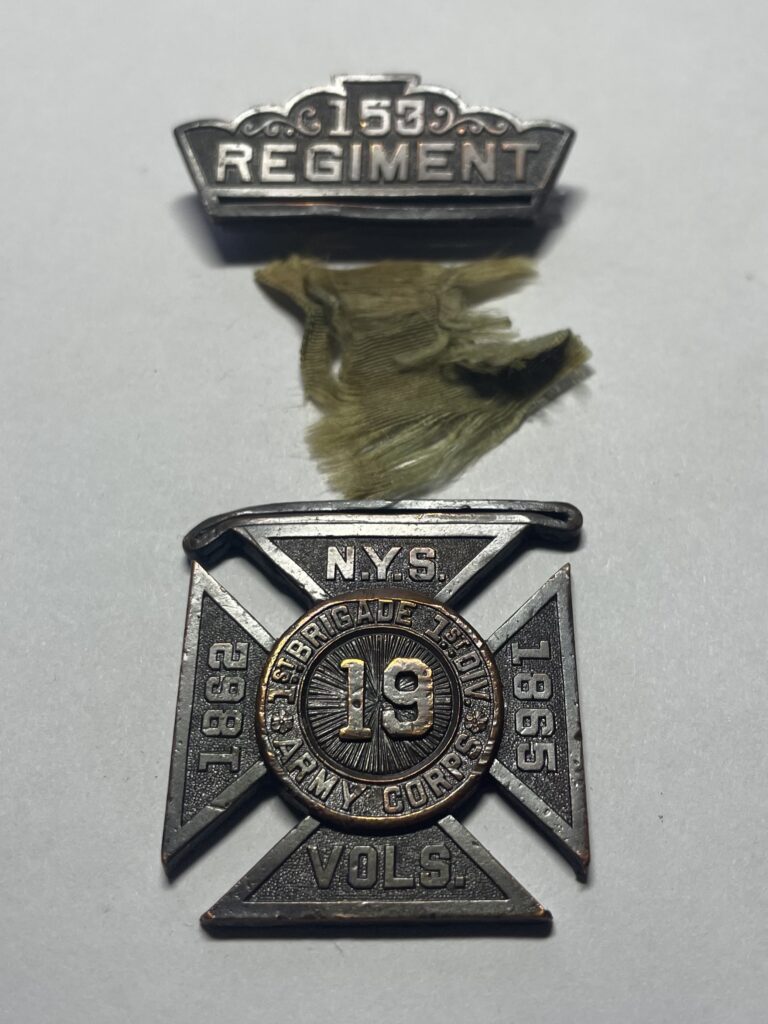
Newspaper Article
The following is a newspaper article from The Johnstown Daily Republican (August 23, 1906, Page 8) that provides an account of the 25th annual reunion of the 153rd Regiment. Thirty-eight of the 250 surviving members of the original 1,300 members attended. It provides a good example of civil war reunion activities associated with the GAR and regimental reunions. William J Griffis was elected treasurer of the GAR based unit, two years before be passed away.

Sons of Veterans of the United States of America
William’s son Charles never served in the military but was an avid member of the Sons of Veterans of the United States of America. The following is a certificate commemorating the election of Charles Griffis as first lieutenant in the SVUSA.
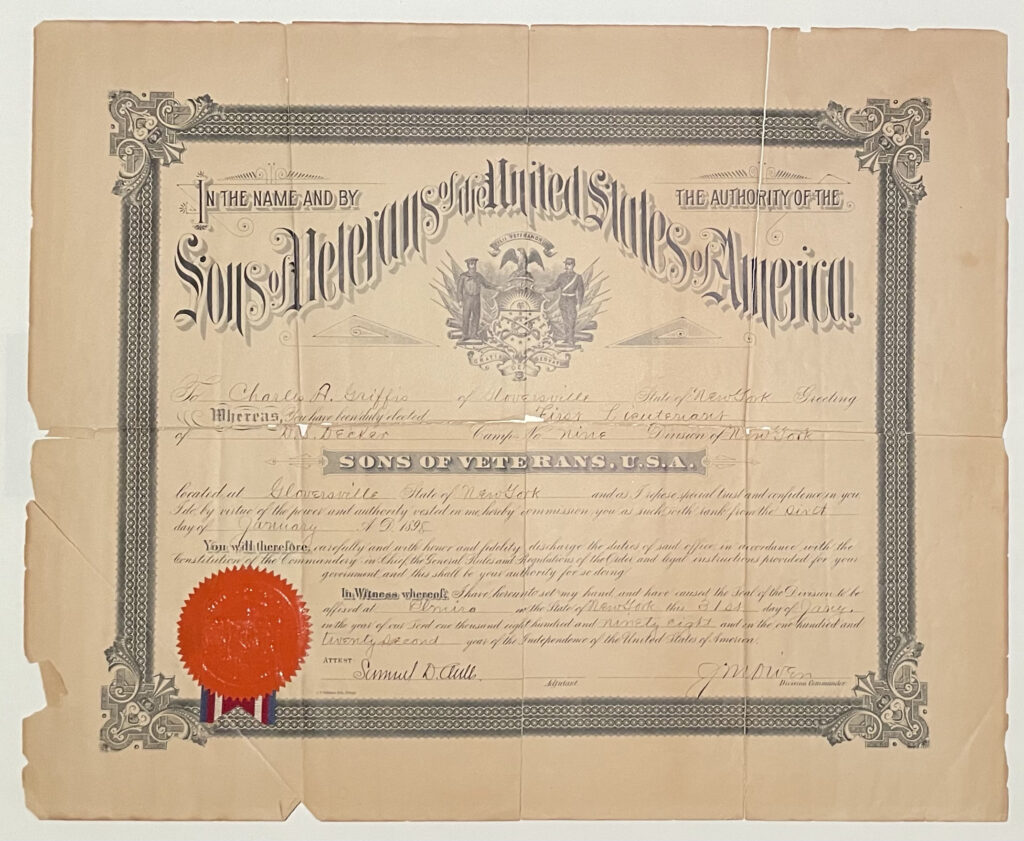
The certificate reads:
“To Charles A. Griffis of Gloversville State of New York Greeting Whereas You have been duly elected First Lieutenant of D.B. Decker Camp No. Nine Division of New York located at Gloversville State of New York and as I repose special trust and confidence in you , I do by virtue of the power and authority vested in me, hereby commission you as such with rank from the sixth day of January A.D. 1898.
“You will therefore carefully and with honor and fidelity discharge the duties of said office in accordance with the Constitution of the Commandery-in-Chief, the General Rules and Regulations of the Order, and Legal Instructions provided for your government and this shall be your authority for serving.
“In Witness whereof I have hereunto set my hand and have caused the Seal of Division to be affixed at Elmira in the State of New York this 31st day of Jany in the year of our Lord one thousand eight hundred and ninety eight and in the one hundred and twenty second years of the Independence of the United States of America.
Attested by Adjutant and Division commander”
The SVUSA was a fraternal organization that carried out educational, patriotic and philanthropic activities to preserve the history and legacy of the Union veterans of the Civil War. It was the legal successor to the Grand Army of the Republic.
Similar to the GAR, most SVUSA activities occurred at the “Camp”, or local community, level. In turn, Camps were grouped into state and/or regional structures called “Departments”. The National organization had their headquarters at the National Civil War Museum in Harrisburg, Pennsylvania. [5]
Charles Griffis’ involvement in the activities of the SVUSA were documented on a number of occasions in the local newspapers of Gloversville.

“Sons of Veterans” Gloversville The Daily Leader., April 06, 1898, Page 5
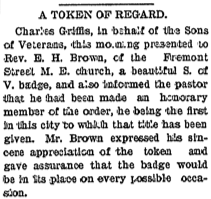
The Johnstown Daily Republican, April 06, 1898, Page 7
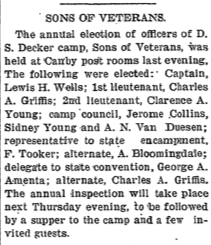
“Sons of Veterans Gloversville The Daily Leader, December 03, 1897, Page 8
Charles continued his various roles and duties in the organization throughout his life. The following are photographs of a “War Chest” parade in Gloversville, New York during World War I around 1917. Charles Griffis is riding a painted horse in the the first photograph.
Sources
[1] U.S. Uniform Buttons: U.S. Military Uniform Button Identification, Inkspot Antiques, accessed January 13, 2021; Scoville Fasteners, Company-Histories.com, accessed January 14, 2021.
[2] 153rd Infantry Regiment, York State Division of Military and Naval Affairs: Military History, Accessed December 20, 2020 Last modified: January 24, 2018
URL: http://www.dmna.state.ny.us/historic/reghist/civil/infantry/153rdInf/153rdInfMain.ht
[3] William H. Horstmann, Autry Museum of the American West’s Collections, online term search
[4] Eichman, Harry, Young, Young, Smith & Co. General Staff Buttons: Early Variants, Generalstaffbuttons.com
[5] Edited by Dean Enderlin, SUVCW National GAR Records Officer, National GAR Records Program – Historical Summary of Grand Army of the Republic (GAR) Posts by State, Page 2 of 29, 30 June 2013, last edited Dec 21, 2020, GAR Records Website: www.garrecords.org specific listing : http://www.suvcw.org/garrecords/garposts/ny.pdf ; also: http://www.suvcw.org/garrecords/garcat/garcat-ny.htm
[6] Grand Review of the Armies, Wikipedia, page accessed on January 14, 2020; Flemming, Thomas, The Big Parade, American Heritage, Volume 41, Issue 2, March 1990; Ross, D. Reed, Civil War Grand Review, History.net, page accessed January 14, 2021; Stroock, William, The Grand Review of 1865, WarfareHistoryNetwork.com, page accessed November 9, 2020.
[7] Gilman, John E. Commander-in-Chief, Grand Army of the Republic, civilwarhome, 1910
[8] The Grand Army of the Republic and Kindred Societies, The Library of Congress, Researcher and References Division, September 13, 2011.; Grand Army of the Republic History, Sons of Union Veterans from the Civil War Website, page accessed October 28, 2020
[9] Studio portrait of H.H. Bennett wearing a GAR uniform, Wisconsin Historical Society, Henry Hamilton Bennett, Title, Image ID 8072. Viewed online at ( https://www.wisconsinhistory.org/Records/Image/IM8072 ); see also 1880s G.A.R. (Grand Army of the Republic) Sackcoat (Blouse), Quartermaster Shop; see also differences between 1880 and 1900 uniforms :
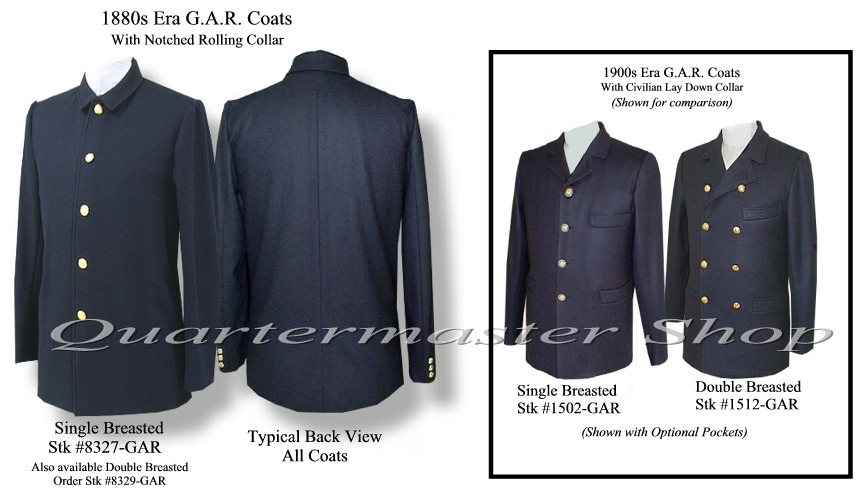
Civil War veteran and amputee Henry A. Seaverns of GAR George W. Perry Post no.31, Scituate, Massachusetts, in uniform with sword, canteen, and other artifacts, standing on crutches in front of American flag, Liljenquist Family Collection of Civil War Photographs, Digital ID: (digital file from original, front) ppmsca 53396 , Library of Congress Prints and Photographs Division Washington, D.C. 20540 USA
[10] Robert J. Wolz, PDC, National Historian of the Sons of Union Veterans of the Civil War, July 2013, Frequently Asked Questions
Mark Sharky, G.A.R. Membership Medal, US Civil War Grand Army of the Republic, Union Army Veteran Samuel Rouse, GAR, Type V 1891 – 1892, March 19, 2008
[11] Ulysses S. Grant Gold GAR Membership badge, National Museum of American History, currently physically not on view (January 2021)
[12] Gilman, John E. Commander-in-Chief, Grand Army of the Republic, civilwarhome, 1910
[13] Ibid
[14] 153rd Infantry Regiment, York State Division of Military and Naval Affairs: Military History, Accessed December 20, 2020 Last modified: January 24, 2018
[15] Sons of Union Veterans of the Civil War, From Wikipedia, referenced page was last edited on 12 January 2021, at 12:56 (UTC)http://www.suvcw.org/?page_id=167



